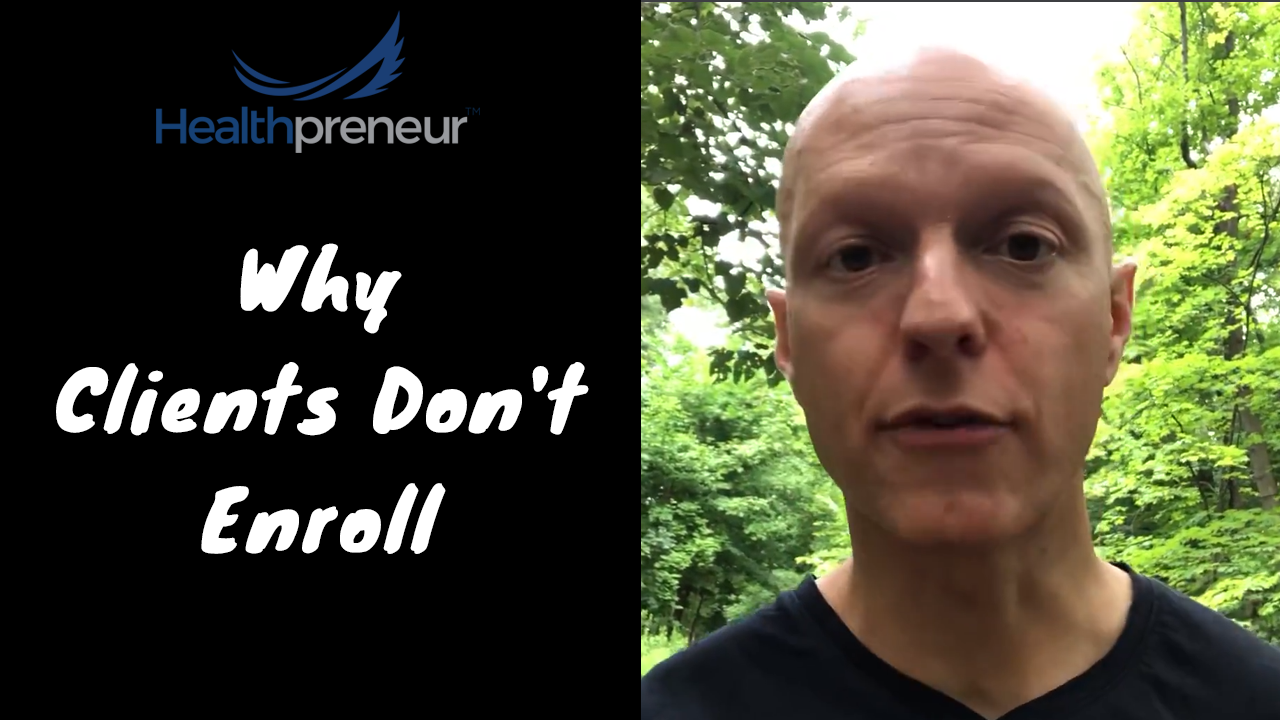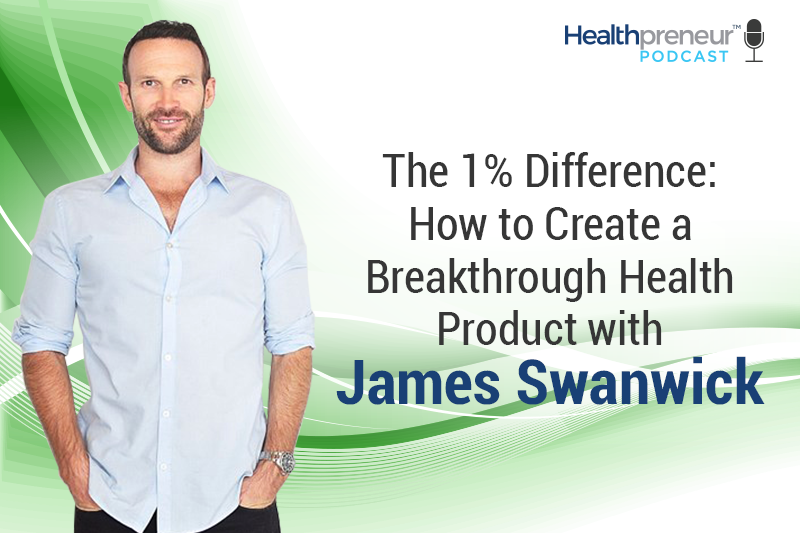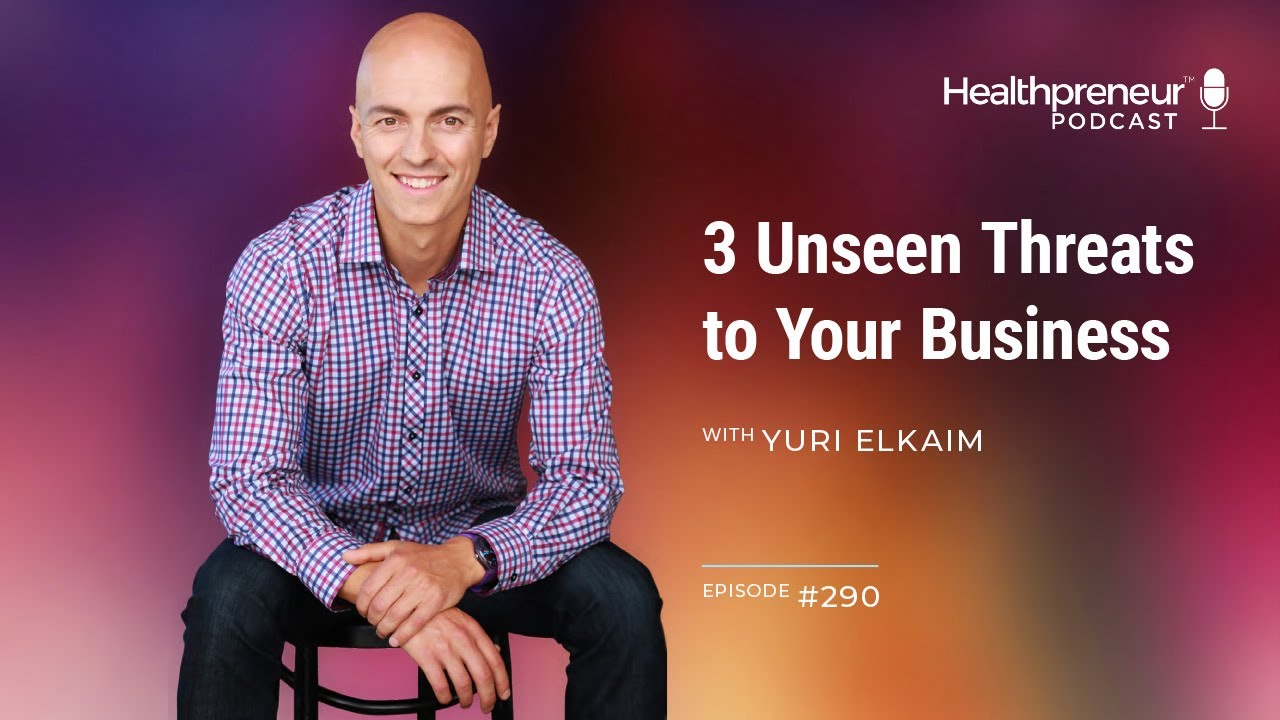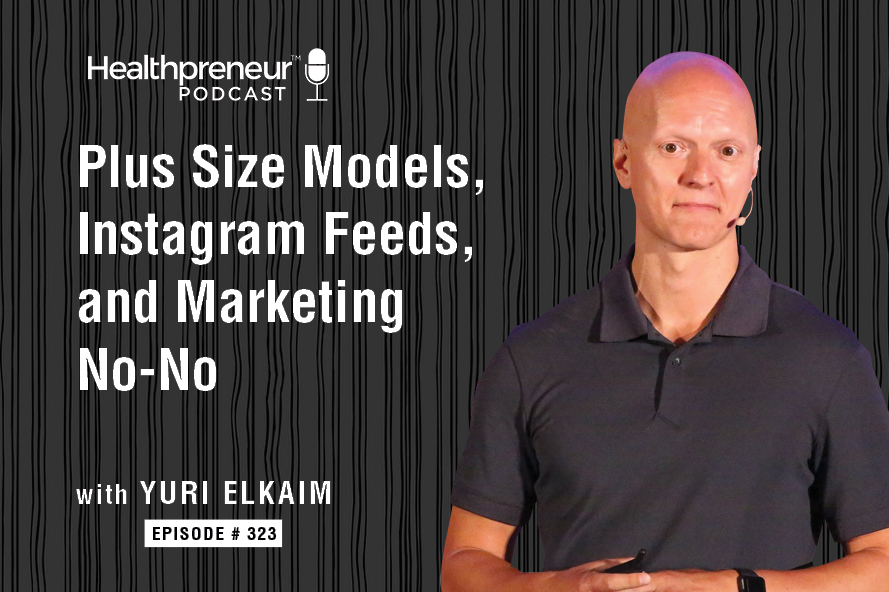Climbing Your Success Ladder
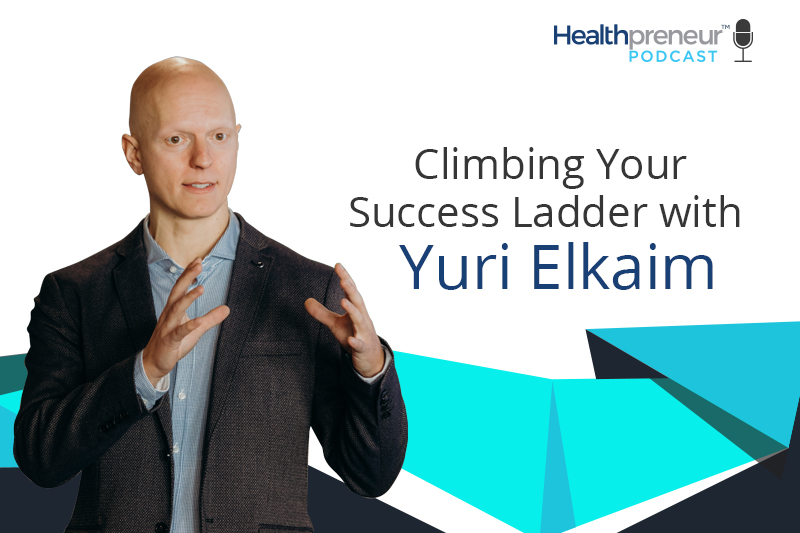
Welcome back to another episode of the Healthpreneur podcast! Today, I’m going to be talking about climbing your success ladder. Specifically, this episode is to help you diagnose exactly where you are in your business so you can know which rung you need to reach next.
Certain questions, like ones about basic tech, indicate that a business is still in its beginning stages. Alternatively, questions about scaling and stepping out of the business start a very different discussion. Neither are wrong, but identifying where you are – honestly – can give you a gauge of where to go next.
Each step of the ladder needs to be mastered before proceeding on to the next. So, if you’re still figuring out the tech to operate your business at its most basic level, for example, you probably aren’t ready to start discussing how to step away from it all and still scale. Tune in to assess where you are, where you want to be, and how to get there.
In This Episode I discuss:
01:00 – 04:00 – Introducing today’s topic, climbing your success ladder, and an example
04:00 – 08:30 – The different components of our business and who we help in each
08:30 – 11:00 – My business goals and vision for this year
11:00 – 14:00 – Figuring out your target market and their major problem
14:00 – 17:00 – A question for you: Where are you in your business?
Transcription
Yuri here. Welcome back to the show. Hope your day is going great. It’s about to get a little bit better or maybe a lot better.
Introducing today’s topic, climbing your success ladder, and an example
In today’s conversation I’m going to be talking with you about climbing your success ladder. What does that really mean? Let me put it this way. It’s very easy to know where someone is at in their business based on the questions that they ask. I want you to listen to this and I want you to listen to this episode as a diagnostic tool to help you identify where you are at in your business.
Let me give you an example. I would say about 60% of clients that we work with are brand new to business, right? They’ve just got their certification or they are randomly doing stuff in their, “business” that really isn’t a business and now we’re helping them build something that is more of a business. A lot of the initial questions that people at this stage start asking is technical questions like, “How do I set up this page? What widget do I use?” All the tech questions. When someone is overwhelmed in tech, you know that they are at the beginning stages of their business for the most part. Nothing wrong with that. There’s nothing wrong with that at all. It’s just understanding that at that stage of business there is a lot of foundational stuff that needs to be built. Understanding what this page should look like, how it integrates with this platform.
One of the things that we do for our clients to alleviate some of that tech is we actually build out their tech for them so that they don’t have to spend a lot of time … Ideally, we want them spending no time in the tech, but obviously everyone has their tendencies, but our goal is to take that off the table so that they can focus on really what matters most, which is their messaging and their offer.
As you climb this ladder, when I say a ladder, I’m talking about the journey of your business. You get into next level discussions, which if we’re talking at the base level, how do I set up this page? What technology do I use here? At one end of the spectrum, the opposite end of the spectrum is, how do I scale this business? How do I scale myself? How do I bring other people on this team? How do I lead a group of people to now allow me to step out of my business and to scale our company to 5 million, 10 million, $100 million a year? That’s a very, very different level of discussion than what webpage do I set up? Or, how do I write a headline? There’s nothing wrong with either one. I think it’s helpful to identify where you are at.
The different components of our business and who we help in each
One of the things that I had to make a decision around was, so we have two core offers. We have our health business accelerator program, which is where we help people from ground zero to earning 10k a month in six months or less. That’s our goal with the program, or adding an additional 10k per month or more to their bottom line by helping them build their Perfect Client Pipeline. Okay. That’s our initial program, it is phenomenal. Now we can’t, we can only do so much in that program without overwhelming people, right? My goal is never to overwhelm our clients, but we also understand that there’s going to be people or clients who get to a point where they’re like, “Listen, like, okay, I got it. I’m good. Now I’m too busy. I need to move myself out of this picture. How do I scale my sales team? How do I scale my coaching? How do I structure my company?” That is stuff that I can’t talk about in the workshop because it wouldn’t make sense if people are talking about how do I set up this webpage and then were having discussions about structuring your company. It’s just way too different. That’s why we have our Luminaries Mastermind for.
Luminaries Mastermind is helping people in our space, health fitness coaches who are doing six figures and want to get to seven and beyond. The big difference there is that yes, your Perfect Client Pipeline, you can do a lot of great stuff with that, but there are things that we can’t do in the initial workshop based on time, the level of where people are at that we can do in the Luminaries that are going to amplify the results of everything we did in the workshop to continue adding consistent streams of revenue, new clients through that pipeline. There’s next level strategies we can look at to really amplify and scale your business and the discussions are very different. The conversations are another level and they should be. The challenge I ran into. When I started the mastermind, I started the mastermind two years ago and it actually came out of necessity. I had two clients, individually didn’t know each other, asked me for one-on-one coaching. I said, “Listen, I can’t stand one-on-one coaching, I suck at it but why not do this? Why don’t we put together a mastermind and you guys will be the first two clients.
I’ll figure out how to fill the rest of it. Sound good?” We did that. We worked together for 12 and 16 months respectively. Initially, the group was fairly small. I think we started out as four people. It grew to 25 in the first year. Our first client, Amanda does not do more than a million dollars a month. We had her on the podcast. Stephen Cabral, another one of my first clients is absolutely crushing it with his business. His business is so busy. He actually had to step down from the mastermind because it was overwhelming. It was a good problem to have for him. Anyways, but we had a lot of people who came into the mastermind who at the time in retrospect probably should not have been in the mastermind because I wasn’t clear on the differentiation between the two, the workshop, the mastermind. What ended up happening was that people who should have been in the workshop should have been in the workshop, and people who should have been in the mastermind should have been in the mastermind.
These are things that you’d learn as you go. Right? You make mistakes, you course correct. We had to part ways with a couple clients. In full transparency, I don’t think the mastermind was set up properly. Personally for me I could have done a much better job in terms of the delivery of the coaching and the contents. Our meetings that we had three times a year were amazing, but kind of in between that is a little bit disheveled. What I decided to do last year was we focus 100% on the workshop. We said, we’re going to dial this bad boy in so we can scale it. I think last year we brought inclusive 300 clients at a relatively high price point. We only did the workshop and I said, I’m going to put the mastermind on the back burner because I know that of these 300 clients, the vast majority of them are not ready for the mastermind. They’re not going to be ready for the mastermind for at least the next six to 12 months. I was willing to take a step back with the mastermind. I kind of compromised the effort I put into that, I was still serving the clients that we had in there but in terms of growing it, there wasn’t much effort there.
My business goals and vision for this year
As we set our goals for 2019, we realized that we had our workshop really dialed in and obviously we’re all doing things to make it a bit better. I said, my focus for this year is to grow our Luminaries Mastermind to 200 members. That’s a very ambitious goal. Okay. Very ambitious goal considering it’s a sizeable investment. My vision was let’s use the workshop to help elevate all of these amazing entrepreneurs and coaches who are, let’s call them in the minor leagues and let’s cultivate them. Let’s help them get success and let’s send them to the pros. The pros in our case is our mastermind. I recognize that. That was probably going to be … I was going to have to go backwards 12 to 16 months to take a step back to cultivate and bring these people up to the point where they could be in the mastermind, if obviously it made sense for both of us. By that point, we’re now having higher level discussions. We’re now having conversations about, listen, I’m doing five or six, seven phone calls a day to enroll clients. It’s great, but I’m going to burn myself out. How do I start building a sales team around me? I’ve done that.
We have four enrollment coaches who do all the calls from me. I don’t do any calls anymore. We got an amazing team of coaches who do most of the coaching in our program. I don’t have to do a lot of coaching. I love what I do, but it’s not me and 300 clients. The cool thing is that because I can introduce that stuff early on because no one’s at that level to make sense of it, we introduce that later on in the mastermind. What does this mean to you? Well, I want you to think of this. When you are working with your clients, you need to be very clear, that initial program you’re offering needs to have a very singular focused promise. Our promise in HBA is we’re going to help you build your Perfect Client Pipeline up to the point where you can add an additional or an initial $10,000 or more per month within six months. That’s how the program is designed. Does everyone get there? No. Sadly, some people take forever to get some simple things done, right? They start second-guessing themselves and all this kind of stuff. That’s the challenge and opportunity of working with people early on in their business.
It’s a lot easier for me to work with someone who’s already doing six figures and give them a couple of tweaks and boom, they’re making a million dollars a month. That is very easy for me to do but we decided as a company, we want to be able to help someone who is brand spanking new, who has as long as they have expertise and they got work ethic, we can build them up. We know that it’s going to be a more challenging road. We also know that it makes us better as coaches. It forces us to systemize things better, forces us to make our trainings better and easier to understand so that we don’t get lazy and expect everyone to understand this stuff. In your business, you need to figure out first and foremost, and this is the first thing we do with our clients in HBA, is you need to figure out who is that single target market? Who’s that perfect client for you? What is the major problem that they’re dealing with? This is another example is for me it’s very easy to see this stuff because I’ve been doing this for almost 15 years now, but for a lot of other people, they don’t see this stuff. They’re looking at it through different lenses.
Figuring out your target market and their major problem
My goal is to empower as many people as possible to think like a marketer, like a CEO eventually. You have to put on different goggles at different stages of your business. Initially, you have to become the marketer, you have to sell for the first while in your business. You got to generate income. As you scale to seven, eight figures, you don’t necessarily do that as much anymore. You might evolve into putting on the goggles of a CEO or maybe you don’t even want to be CEO. You just want to be the content person and you hire someone else to be the CEO. Initially, you can’t even think about that stuff until you make sales. Right? Initially, you got to master selling, you got to really be good at marketing and messaging and so forth and that’s the first thing you need to really figure out in your business is who is the single target market? What is the single major pain or problem that they want solved? Getting healthy is not good enough. Getting fit is not good enough. It’s not going to work especially if you’re charging premium prices. Nobody is going to give you three, four, $5,000 to help me get healthy, but you need to figure out what is really keeping them up at night.
The good news is that if you’ve been coaching clients in person or one-on-one, you’ve been having these discussions with them already. You don’t need to do surveys and market data and that kind of stuff. You already know this stuff because you’ve been working with clients most likely. Figure out who is the single audience because if you don’t figure out a single audience, here’s what’s going to happen. You end up having a bunch of one-on-one clients with different problems and then your messaging is all over the place. I help people with this, this, this, this. I help people get healthy and feel great again. Great, so does everybody else. You don’t send out, you don’t differentiate yourself, therefore you’re not going to be able to command premium prices. When you’re on the phone with someone they’re like, “Yeah, let me think about it.” What they’re saying is, “I don’t think you can solve my problem,” because a lot of other people, including a $20 book can do that. You need to figure out the major pain. Someone’s got to get on the phone with you because they’re in a very bad situation.
If they’re not in a very bad situation, you need to filter those people out so they don’t get on the phone with you in the first place. We could talk about this for hours. Quite honestly, this episode can go on for seven hours but I just want to kind of bring things back in for a second.
A question for you: Where are you in your business?
I want you to think to yourself, where am I in my business? Am I somebody who is still trying to figure out the technology? Am I at a point now where I’m starting to craft better messaging and better offers? Am I at a point where sales are coming in, clients are coming in and I’m starting to get a little bit overwhelmed? I’m starting to think of, how do I clone myself? How do I build a team? How do I build a great company, right? Because the conversations at those different points in your business are going to be different. What I would love for you to do is pop over to Instagram and find me @healthpreneur1 and I’d love for you to send me a direct message just, “Hey, I listened to this episode, climbing the success ladder. It was really cool,” or it sucked, whatever you want to say it doesn’t matter to me. Let me know.
Send me a direct messages and just let me know what stage of business you’re in. Where are you at in your business? What is the biggest challenge you’re currently dealing with? Now, if you’re one of our clients, you don’t need to send me that because I speak with you pretty much every day, so we’re all good, but if you’re just a listener, then hit me up on Instagram. Cool. I hope this episode has helped you out. Hopefully it’s given you some food for thought. I look forward to seeing you in our next episode. I will be actually talking about the one objection that is crushing your business and your clients. If you’re on the phone and this objection is coming up, it will sabotage your business. That’s coming your way on Monday. Do not miss that one. In the meantime, hope you have an amazing day. Hit me up on Instagram and I’ll see you soon. Hey, thanks so much for joining us on this episode of the Healthpreneur Podcast. If you’ve enjoyed this episode, here’s what I’d like you to do right now. If you haven’t done so already, please subscribe to the Healthpreneur Podcast on iTunes and while you’re there, leave us a rating or review. It helps us get in front of more people and change more lives.
If you’re ready to start or scale your health or fitness coaching business and want to start getting in front of more people, working with them at a higher level without trading time for money then I invite you to check out our free seven figure health business blueprint training totally free right now, and you can do so at healthpreneurgroup.com/training.
For now, thank you so much for joining us. Continue to be great, do great. I look forward to seeing you in the next episode.
If you enjoyed this episode, head on over to iTunes and subscribe to Healthpreneur™ Podcast if you haven’t done so already.
While you’re there, leave a rating and review. It really helps us out to reach more people because that is what we’re here to do.
What You Missed
In our last episode, I talked about speaking on stage and whether you should consider doing it as part of your business.
There are a lot of speakers out there who are on the road more than they’re home. There are also many speakers who are in and out of speaking gigs; they show up, talk, and go home. Me, I’m more about the connection and relationship I make with the people I meet through speaking engagements.
But I’ve found that something else is much more effective and scalable than speaking onstage – and it provides more time freedom. It’s something that keeps working for you – even when you’re on vacation – while still providing you the comfort of predictable income.
Does this sound good? Tune in to find out more!
Related posts
December 27, 2017
The 1% Difference: How to Create a Breakthrough Health Product with James Swanwick
Hey Healthprenuers, today we’ve…
February 14, 2020
Plus Size Models, Instagram Feeds, and Marketing No-No
In this episode I want to talk…


